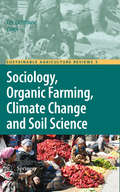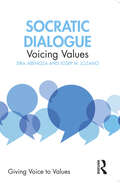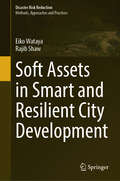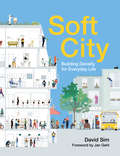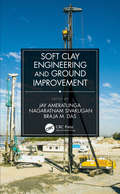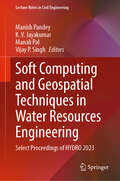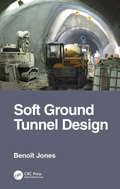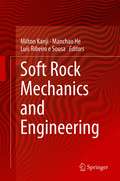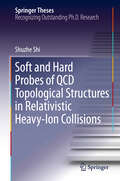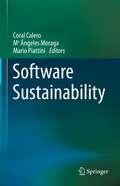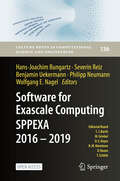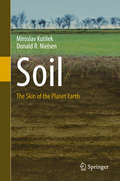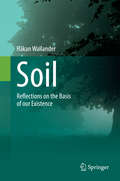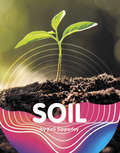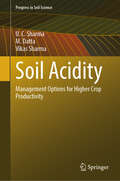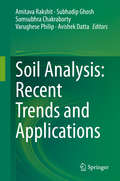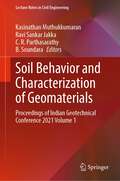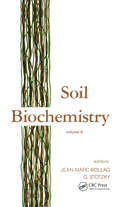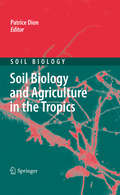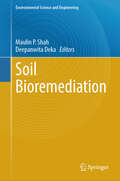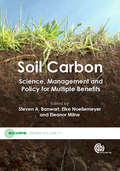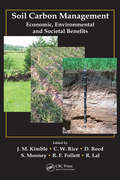- Table View
- List View
Sociology, Organic Farming, Climate Change and Soil Science
by Eric LichtfouseSustainable agriculture is a rapidly growing field aiming at producing food and energy in a sustainable way for humans and their children. Sustainable agriculture is a discipline that addresses current issues such as climate change, increasing food and fuel prices, poor-nation starvation, rich-nation obesity, water pollution, soil erosion, fertility loss, pest control, and biodiversity depletion. Novel, environmentally-friendly solutions are proposed based on integrated knowledge from sciences as diverse as agronomy, soil science, molecular biology, chemistry, toxicology, ecology, economy, and social sciences. Indeed, sustainable agriculture decipher mechanisms of processes that occur from the molecular level to the farming system to the global level at time scales ranging from seconds to centuries. For that, scientists use the system approach that involves studying components and interactions of a whole system to address scientific, economic and social issues. In that respect, sustainable agriculture is not a classical, narrow science. Instead of solving problems using the classical painkiller approach that treats only negative impacts, sustainable agriculture treats problem sources. Because most actual society issues are now intertwined, global, and fast-developing, sustainable agriculture will bring solutions to build a safer world. This book series gathers review articles that analyze current agricultural issues and knowledge, then propose alternative solutions. It will therefore help all scientists, decision-makers, professors, farmers and politicians who wish to build a safe agriculture, energy and food system for future generations.
Socratic Dialogue: Voicing Values (Giving Voice to Values)
by Josep M. Lozano Sira AbenozaGiving Voice to Values is a very important tool that has helped many professionals better align what they do with what they value and believe. This book introduces the methodology of Socratic Dialogue as a complementary set of tools for creating spaces of joint reflection in which one can gain clarity about one’s values and gain the confidence to voice them effectively. Socrates’ main concern was to progressively reach a higher alignment between ideas and actions: that is, to achieve a harmony between what we think, what we say and what we do. The first step to giving voice to our values involves introspection and dialogue with others – which is how we can become aware of what we really think and value. An examined life, Socrates reminds us, is a fulfilled one. Based on the authors' more than ten years’ experience teaching Socratic Dialogue to business and law students, executives and professionals, faculty, incarcerated people and other vulnerable groups, the book provides teachers and practitioners with a roadmap to conceive, design and conduct Socratic Dialogue courses and sessions. It provides context for the method and its adaptation to the challenges of the 21st century. The book also offers guidance on how to structure a Socratic Dialogue classroom, as well as a series of tried-and-true activities and exercises, practical recommendations and testimonies of the transformative impact that dialogue courses have had on participants. The book is of prime interest to professors and educators of business ethics, as well as professional consultants working to help organizations become more responsible and introduce ethical reasoning in their decisions. It also serves as a valuable resource for social educators and practitioners in prisons and rehabilitation units, as well as teachers in primary and secondary education.
Soft Assets in Smart and Resilient City Development (Disaster Risk Reduction)
by Rajib Shaw Eiko WatayaOver the past decade, building smarter, resilient cities is an established global trend in urban development, including developing countries. Unexpected external shocks, disasters and damage from climate change have major impacts on sustainable growth and well-being for citizens in today’s cities and requires comprehensive solutions. To deal with these negative events, cities predominantly invest in hard physical infrastructure, with less attention on non-physical soft assets which are intangible in nature and more difficult to quantify, but essential to achieve effective, balanced sustainable development. The value of soft assets can be substantial, and consistent implementation by cities can generate diverse value and be transformative for their urban development. For that purpose, cities need to establish an appropriate strategy, framework and structure to incorporate soft assets during the plan and implementation of hard infrastructure. This book argues that integrating soft assets in smart, resilient city development is critical to make the hard infrastructure work effectively and create value for cities. The literature review underlines that soft capital can be defined as: 1) human, 2) institutional, 3) external, 4) technology and information, and 5) social. The book also examines how soft assets can be effectively integrated into and create value for smart, resilient city development. Based on previous findings and original research, a unique approach is adopted through the verification of different city-level approaches using the concept of influential nodes, showcasing layered and composite value creation. The analysis addresses innovative implementation factors which enhance disaster resilience and the environment, which is particularly relevant for cities in developing countries. Drawing on previous research, in-depth reviews, new data, and case studies, the book provides new insights and specific policy and action measures to enhance the utilization of soft asset components in parallel with hard infrastructure in smart and resilient city in developing countries.
Soft City: Building Density for Everyday Life
by David SimIn Soft City David Sim, partner and creative director at Gehl, shows how cities with well-designed density can result in a higher quality of life. He presents ideas and graphic examples from around the globe. He draws from his vast design experience to make a case for a dense and diverse built environment at a human scale, which he presents through a series of observations of older and newer places, and a range of simple built phenomena, some traditional and some totally new inventions. Soft City offers inspiration, ideas, and guidance in a highly visual package, for anyone interested in city building. Sim shows how to make any city more efficient, more livable, and better connected to the environment.
Soft Clay Engineering and Ground Improvement
by Braja M. Das Jay Ameratunga Nagaratnam SivakuganSoft Clay Engineering and Ground Improvement covers the design and implementation of ground improvement techniques as applicable to soft clays. This particular subject poses major geotechnical challenges in civil engineering. Not only civil engineers, but planners, architects, consultants and contractors are now aware what soft soils are and the risks associated with development of such areas. The book is designed as a reference and useful tool for those in the industry, both to consultants and contractors. It also benefits researchers and academics working on ground improvement of soft soils, and serves as an excellent overview for postgraduates. University lecturers are beginning to incorporate more ground improvement topics into their curricula, and this text would be ideal for short courses for practicing engineers. It includes several examples to assist a newcomer to carry out preliminary designs. The three authors, each with dozens of years of experience, have witnessed and participated in the rapid evolvement of ground improvement in soft soils. In addition, top-tier professionals who deal with soft clays and ground improvement on a daily basis have contributed, providing their expertise in dealing with real-world problems and practical solutions.
Soft Computing and Geospatial Techniques in Water Resources Engineering: Select Proceedings of HYDRO 2023 (Lecture Notes in Civil Engineering #397)
by Vijay P. Singh Manish Pandey K. V. Jayakumar Manali PalThis book comprises proceedings of the 28th International Conference on Hydraulics, Water Resources, River and Coastal Engineering (HYDRO 2023). It focuses on emerging opportunities and challenges in the field of soft computing and geospatial techniques in water resources engineering. The book covers a range of topics including, but not limited to, satellite-derived data for hydrologic applications, Geospatial Information System (GIS) and Remote Sensing (RS) applications in water resources management, rainfall and streamflow prediction, hydro-informatics, data-driven and artificial intelligent-based hydrological modelling, optimization of water resources systems. The book presents these topics in the form of illustrations and tables, thereby providing the readers with an in-depth insight into the recent research. It also addresses fundamental concepts and studies in the field of soft computing and geospatial techniques in water resources engineering, making it a valuable resource for researchers and professionals working in the fields of hydraulics, water resources and coastal engineering.
Soft Ground Tunnel Design
by Benoit JonesSoft Ground Tunnel Design is a textbook that teaches the principles of tunnel and underground space design in soft ground. ‘Soft ground’ refers to soil, in contrast to rock. The book focuses on stability, prediction of ground movements, and structural design of the lining. It shows that the choice of excavation and support methods depends on ground stability, limitation of damage to the existing built environment, and health, safety and environmental considerations. Benoît Jones builds on the basic principles of soil-structure interaction, the three-dimensional effects of construction sequence, and the effects of construction on other surface or subsurface structures in steps of gradually increasing complexity. The use of worked examples throughout, and example problems at the end of each chapter, give the reader confidence to apply their knowledge. Engineers and graduate students will be able to: • understand the basis for choosing an underground construction method and/or ground improvement method • calculate heading stability • predict ground movements • understand the complex soil-structure interaction around an advancing tunnel • design tunnel linings in soft ground using a variety of methods • predict the effects of construction on the built environment and assess potential damage Benoît Jones has worked in tunnelling as a designer, contractor and academic for more than 20 years. He set up and ran the MSc Tunnelling and Underground Space course at the University of Warwick. He is now managing director of his own company, Inbye Engineering.
Soft Rock Mechanics and Engineering
by Milton Kanji Manchao He Luís Ribeiro e SousaThis book offers a practical reference guide to soft rock mechanics for engineers and scientists. Written by recognized experts, it will benefit professionals, contractors, academics, researchers and students working on rock engineering projects in the fields of civil engineering, mining and construction engineering. Soft Rock Mechanics and Engineering covers a specific subject of great relevance in Rock Mechanics – and one that is directly connected to the design of geotechnical structures under difficult ground conditions. The book addresses practical issues related to the geomechanical properties of these types of rock masses and their characterization, while also discussing advances regarding in situ investigation, safety, and monitoring of geotechnical structures in soft rocks. Lastly, it presents important case histories involving tunnelling, dam foundations, coal and open pit mines and landslides.
Soft Spaces in Europe: Re-negotiating governance, boundaries and borders (Regions and Cities)
by Jörg Knieling Graham Haughton Frank Othengrafen Phil AllmendingerThe past thirty years have seen a proliferation of new forms of territorial governance that have come to co-exist with, and complement, formal territorial spaces of government. These governance experiments have resulted in the creation of soft spaces, new geographies with blurred boundaries that eschew existing political-territorial boundaries of elected tiers of government. The emergence of new, non-statutory or informal spaces can be found at multiple levels across Europe, in a variety of circumstances, and with diverse aims and rationales. This book moves beyond theory to examine the practice of soft spaces. It employs an empirical approach to better understand the various practices and rationalities of soft spaces and how they manifest themselves in different planning contexts. By looking at the effects of new forms of spatial governance and the role of spatial planning in North-western Europe, this book analyses discursive changes in planning policies in selected metropolitan areas and cross-border regions. The result is an exploration of how these processes influence the emergence of soft spaces, governance arrangements and the role of statutory planning in different contexts. This book provides a deeper understanding of space and place, territorial governance and network governance.
Soft and Hard Probes of QCD Topological Structures in Relativistic Heavy-Ion Collisions (Springer Theses)
by Shuzhe ShiThis thesis makes significant advances in the quantitative understanding of two intrinsically linked yet technically very different phenomena in quantum chromodynamics (QCD). Firstly, the thesis investigates the soft probe of strong interaction topological fluctuations in the quark-gluon plasma (QGP) which is made possible via the anomalous chiral transport effects induced by such fluctuations. Here, the author makes contributions towards establishing the first comprehensive tool for quantitative prediction of the chiral magnetic effect in the QGP that is produced in heavy ion collision experiments. Secondly, the thesis deals with the hard probe of strongly coupled QGP created in heavy-ion collisions. In particular, this study addresses the basic question related to the nonperturbative color structure in the QGP via jet energy loss observables. The author further develops the CUJET computational model for jet quenching and uses it to analyze the topological degrees of freedom in quark-gluon plasma. The contributions this thesis makes towards these highly-challenging problems have already generated widespread impacts in the field of quark-gluon plasma and high-energy nuclear collisions.
Software Sustainability
by Coral Calero Mario Piattini Mª Ángeles MoragaThis book focuses on software sustainability, regarded in terms of how software is or can be developed while taking into consideration environmental, social, and economic dimensions. The sixteen chapters cover various related issues ranging from technical aspects like energy-efficient programming techniques, formal proposals related to energy efficiency measurement, patterns to build energy-efficient software, the role of developers on energy efficient software systems and tools for detecting and refactoring code smells/energy bugs; to human aspects like its impact on software sustainability or the adaptation of ACM/IEEE guidelines for student and professional education and; and an economics-driven architectural evaluation for sustainability. Also aspects as the elements of governance and management that organizations should consider when implementing, assessing and improving Green IT or the relationship between software sustainability and the Corporate Social Responsibility of software companies are included. The chapters are complemented by usage scenarios and experience reports on several domains as cloud applications, agile development or e-Health, among others. As a whole, the chapters provide a complete overview of the various issues related to sustainable software development. The target readership for this book includes CxOs, (e.g. Chief Information Officers, Chief Executive Officers, Chief Technology Officers, etc.) software developers, software managers, auditors, business owners, and quality professionals. It is also intended for students of software engineering and information systems, and software researchers who want to know the state of the art regarding software sustainability.
Software for Exascale Computing - SPPEXA 2016-2019 (Lecture Notes in Computational Science and Engineering #136)
by Hans-Joachim Bungartz Wolfgang E. Nagel Philipp Neumann Severin Reiz Benjamin UekermannThis open access book summarizes the research done and results obtained in the second funding phase of the Priority Program 1648 "Software for Exascale Computing" (SPPEXA) of the German Research Foundation (DFG) presented at the SPPEXA Symposium in Dresden during October 21-23, 2019. In that respect, it both represents a continuation of Vol. 113 in Springer’s series Lecture Notes in Computational Science and Engineering, the corresponding report of SPPEXA’s first funding phase, and provides an overview of SPPEXA’s contributions towards exascale computing in today's sumpercomputer technology. The individual chapters address one or more of the research directions (1) computational algorithms, (2) system software, (3) application software, (4) data management and exploration, (5) programming, and (6) software tools. The book has an interdisciplinary appeal: scholars from computational sub-fields in computer science, mathematics, physics, or engineering will find it of particular interest.
Soil
by Miroslav Kutílek Donald R. NielsenThe main focus of this monograph is to explain the important role of soil and the environment to a broad audience. Soil is one of the five essential factors crucial for human life. On the one hand the authors describe a responsible approach and use of soil, established on a basic knowledge of the nature of soil and the countless ongoing processes within soil. On the other hand they explain the precarious link between soil and regional environment, which is indispensable for plant and animal communities. In addition to these topics its chapters describe the unique roles of soil texture, soil structure and soil pore systems in hydrologic cycles, plant nutrition and conditions affecting the preservation or eventual extinction of soil. This book concludes with the principles of soil protection and revitalization. General readers with an interest in biology, chemistry, physics or geology will find this book highly informative.
Soil
by Håkan WallanderHåkan Wallander is a professor in Soil Biology and the reader is guided through the fascinating world below ground. The book has a free form and the author mixes scientific facts with personal stories from active research experiences and everyday life. The main focus is to make the reader aware of the vast biodiversity that exists in the soil, and to describe the important processes provided by the soil organisms. Reflections are made on how dependent we are on living soils, and how vulnerable the soil is if managed in a wrong way. The importance of soils as carbon sinks and reflections about the possible influence of soils for taste and quality of food and wine is also covered. The book is illustrated with photographs and every picture has a legend that stands on its own. In this way the reader will have an easy way into the book, and the main aim is to gain new readers to a subject that is immensely important, but not very attractive to laypersons.
Soil (Earth Materials and Systems)
by Keli SipperleySoil covers most of the land on Earth. It feeds plants and is home to many animals. Discover why soil is an important part of nature!
Soil (Rocks and Minerals)
by Melissa StewartHave you ever wondered how soil is different from dirt, or where soil comes from? Do you know the different animals and organisms that live in soil? What are the many ways that we use soil? Read Soil to find the answers to these questions and many more. You'll also find a hands-on activity to try at home or at school, as well as a glossary of unfamiliar words, resources to help you locate additional information, and a useful index.
Soil Acidity: Management Options for Higher Crop Productivity (Progress in Soil Science)
by Vikas Sharma U. C. Sharma M. DattaThe book on acid soils offers a thorough analysis of the degree of soil acidity at the global level, information on the biota, chemistry, and behaviour of acid soils, as well as the mechanisms by which plants tolerate soil acidity. It also offers crop management strategies that make effective use of amendments and acid soil-specific crop management practices. Crop output, forest health, and aquatic life all suffer from acidic soil. The main causes are the toxicity of aluminium (Al) and/or manganese (Mn), as well as the deficiencies of calcium (Ca), magnesium (Mg), phosphorus (P), and molybdenum (Mo), to a lesser extent. Lack of calcium affects the health and integrity of cells, which lowers agricultural yield and quality. To achieve the highest crop productivity, management options have been provided. All concerned will find this book of great assistance in solving the global food crisis in a sustainable manner.
Soil Analysis: Recent Trends and Applications
by Amitava Rakshit Subhadip Ghosh Somsubhra Chakraborty Varughese Philip Avishek DattaSoil analysis is critically important in the management of soil-based production systems. In the absence of efficient methods of soil analysis our understanding of soil is pure guesswork. Ideally the pro-active use of laboratory analysis leads to more sustainable soil productivity. Unfortunately, most of the world’s agriculture is still reactionary, waiting for obvious yield declines to occur before taking action to identify the reasons. The modern soil laboratory is pivotal to informing soil managers what adaptive practices are needed to address chemical and physical imbalances before they occur, and the intelligent adaptive use of laboratory data not only greatly speeds up and reduces the cost of empirical soil study, but can even render it unnecessary. This book provides a synopsis of the analytical procedures used for soil analysis, discussing the common physical, chemical and biological analytical methods used in agriculture and horticulture. Written by experienced experts from institutions and laboratories around the globe, it provides insights for a range of users, including those with limited laboratory facilities, and helps students, teachers, soil scientists and laboratory technicians increase their knowledge and skills and select appropriate methods for soil analysis.
Soil Behavior and Characterization of Geomaterials: Proceedings of Indian Geotechnical Conference 2021 Volume 1 (Lecture Notes in Civil Engineering #296)
by C. R. Parthasarathy Kasinathan Muthukkumaran Ravi Sankar Jakka B. SoundaraThis book comprises the select peer-reviewed proceedings of the Indian Geotechnical Conference (IGC) 2021. The contents focus on Geotechnics for Infrastructure Development and Innovative Applications. The book covers topics related to soil behavior and characterization of geomaterials, geotechnical, geological, and geophysical investigation of special topics such as behavior of unsaturated soils, offshore and marine geotechnics, remote sensing and GIS, instrumentation and monitoring, retrofitting of geotechnical structures, reliability in geotechnical engineering, geotechnical education, codes and standards, among others. This volume will be of interest to those in academia and industry.
Soil Biochemistry: Volume 8
by Jean-Marc Bollag G. StotzkyStressing the potential application of biochemical processes in soil to environmental biotechnology, this state-of-the-art reference considers the vital role that such biochemical processes have in the environment - emphasizing the activity of micro-organisms in soil.;An up-to-date analysis of biological reactions in soil, Volume 8 of Soil Biochemistry highlights: traditional as well as molecular and immunlogical techniques for detecting specific micro-organisms in soil; the fate of introduced genetically-modified organisms; the problem of competition by the indigenous microbial populations with the introduced organisms; the use of a white rot fungus, Phanerochaete chrysosporium, for bioremediative purposes in soil; the interaction of xenobiotics, such as pesticides, with soil organisms; generic microbial metabolism and degradation pathways; the inhibition of the nitrification process by allelochemicals released by plants; the microbial mineralization of various compounds under anaerobic conditions, explaining its importance in the global carbon cycle; the formation of soil organic matter, particularly in forest soils; and CPMAS 13C-NMR spectroscopy, a major analytical technique to determine the chemicals or chemical groups involved in the humification process.;Presenting a multidisciplinary approach to the field by internationally acclaimed scientists, Soil Biochemistry, Volume 8 is intended for professionals and students in the fields of soil science; microbiology; biochemistry; environmental science, engineering and technology; biogeochemistry; biotechnology; agronomy; plant pathology; and microbial ecology.
Soil Biology and Agriculture in the Tropics
by Patrice DionThe relationships between soils, microbes and humans are of crucial relevance in the tropics, where plant stress and microbial activity are exacerbated. This volume of Soil Biology presents the living component of tropical soils, showing how it is shaped by environmental conditions and emphasizing its dramatic impact on human survival and well-being. Following an introduction to the specificities of tropical soils and of their microbial communities, the biological aspects of soil management are examined, dealing with land use change, conservation and slash-and-burn agriculture, the restoration of hot deserts, agroforestry and paddy rice cultivation. As they are of particular relevance for tropical agriculture, symbioses of plants and microbes are thoroughly covered, as are the biodegradation of pesticides and health risks associated with wastewater irrigation. Lastly, traditional soil knowledge is discussed as a key to our sustainable presence in this world.
Soil Bioremediation (Environmental Science and Engineering)
by Maulin P. Shah Deepanwita DekaThis book is presented on bioremediation of soil including different aspects for sustainable development of agriculture, environment etc. Significant attention is being paid to plants and microbes because of their metabolomics, molecular mechanisms, biochemical pathways, bioengineering, and cost-effective nature in an eco-friendly green approach. It presents a detailed account on phytoremediation, microbial remediation; application of different plants and microorganisms for bioremediation in agricultural soil; nanoparticles, metabolites produced by plants and microbes for bioremediation of soil; multidisciplinary approaches of bioremediation to alleviate major soil contamination issues, molecular mechanisms, biochemical approach of bioremediation of soil; plants and microbial engineering for bioremediation; recent advances and challenges; future prospects of bioremediation of contaminated soil, utilizing biodiversity for sustainable development of the soil ecosystem.
Soil Carbon
by Meine Van Noordwijk Pete Smith Christiano Ballabio Daniel Buschiazzo Elke Noellemeyer Steven A Banwart Bas Van Wesemael Genxing Pan Francesca Bampa Rich Conant Heitor L.C. Coutinho Patrick Gicheru Andre Bationo Roger Funk David Werner Martial Bernoux Unai Pascual Tapas Bhattacharyya Marty Goldhaber Hans Joosten Dave Abson Niels Batjes Carlos Eduardo Cerri Generose Nziguheba David Powlson Christian Feller Pierre-Alain Maron Luca Montanarella Yongcun Zhao Chris Duffy Eleanor MilneThis book brings together the essential evidence and policy opportunities regarding the global importance of soil carbon for sustaining Earth's life support system for humanity. Covering the science and policy background for this important natural resource, it describes land management options that improve soil carbon status and therefore increase the benefits that humans derive from the environment. Written by renowned global experts, it is the principal output from a SCOPE rapid assessment process project. Read a chapter for free
Soil Carbon Dynamics
by Werner L. Kutsch Michael Bahn Andreas HeinemeyerCarbon stored in soils represents the largest terrestrial carbon pool and factors affecting this will be vital in the understanding of future atmospheric CO2 concentrations. This book provides an integrated view on measuring and modeling soil carbon dynamics. Based on a broad range of in-depth contributions by leading scientists it gives an overview of current research concepts, developments and outlooks and introduces cutting-edge methodologies, ranging from questions of appropriate measurement design to the potential application of stable isotopes and molecular tools. It includes a standardised soil CO2 efflux protocol, aimed at data consistency and inter-site comparability and thus underpins a regional and global understanding of soil carbon dynamics. This book provides an important reference work for students and scientists interested in many aspects of soil ecology and biogeochemical cycles, policy makers, carbon traders and others concerned with the global carbon cycle.
Soil Carbon Management: Economic, Environmental and Societal Benefits
by R. Lal J. M. Kimble C. W. Rice D. Reed S. Mooney R. F. FollettBetter Manage Soil C for Improved Soil Quality In the United States, soil has fueled the availability of abundant, safe food, thus underpinning economic growth and development. In the future we need to be more vigilant in managing and renewing this precious resource by replacing the nutrients and life-sustaining matter that we remove for
